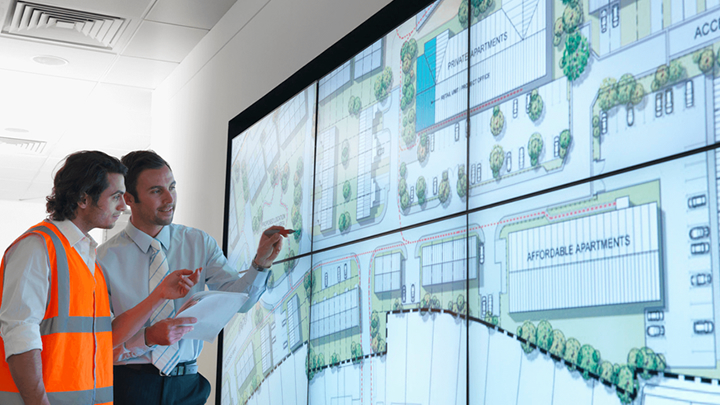Work Environment
This occupation is typically found in the following Career Sector(s):
Videos & Interviews
Videos on the Web
- Landscape Architect / Designer- from: Youtube Search
- Landscape Architect- from: icould [UK] Video
Most commonly reported Work Activities
- Getting Information Observing, receiving, and otherwise obtaining information from all relevant sources.
- Thinking Creatively Developing, designing, or creating new applications, ideas, relationships, systems, or products, including artistic contributions.
- Interacting With Computers Using computers and computer systems (including hardware and software) to program, write software, set up functions, enter data, or process information.
- Drafting, Laying Out, and Specifying Technical Devices, Parts, and Equipment Providing documentation, detailed instructions, drawings, or specifications to tell others about how devices, parts, equipment, or structures are to be fabricated, constructed, assembled, modified, maintained, or used.
- Making Decisions and Solving Problems Analysing information and evaluating results to choose the best solution and solve problems.
- Communicating with Persons Outside Organisation Communicating with people outside the organisation, representing the organisation to customers, the public, government, and other external sources. This information can be exchanged in person, in writing, or by telephone or e-mail.
- Communicating with Supervisors, Peers, or Subordinates Providing information to supervisors, co-workers, and subordinates by telephone, in written form, e-mail, or in person.
- Organising, Planning, and Prioritising Work Developing specific goals and plans to prioritise, organise, and accomplish your work.
- Evaluating Information to Determine Compliance with Standards Using relevant information and individual judgment to determine whether events or processes comply with laws, regulations, or standards.
- Establishing and Maintaining Interpersonal Relationships Developing constructive and cooperative working relationships with others, and maintaining them over time.
Working Life
Landscape architects plan and design all types of outdoor spaces such as recreational areas, roads and reservoirs. They also look at the settings for buildings in town and country. In towns, landscape architects may work on the grounds of hospitals, housing estates, parks and play areas. In rural areas, landscape architects work on agricultural, forest and tourist landscapes, and the grounds of power stations and industrial buildings. The design of public and private gardens may also be part of their work.
Most commonly reported Work Tasks
- Prepare graphic representations or drawings of proposed plans or designs.
- Confer with clients, engineering personnel, or architects on landscape projects.
- Integrate existing land features or landscaping into designs.
- Inspect landscape work to ensure compliance with specifications, evaluate quality of materials or work, or advise clients or construction personnel.
- Analyse data on conditions such as site location, drainage, or structure location for environmental reports or landscaping plans.
- Develop marketing materials, proposals, or presentations to generate new work opportunities.
- Manage the work of subcontractors to ensure quality control.
- Present project plans or designs to public stakeholders, such as government agencies or community groups.
- Prepare site plans, specifications, or cost estimates for land development.
- Create landscapes that minimise water consumption such as by incorporating drought-resistant grasses or indigenous plants.
Further Information
- Landscape Architect- from: N.C.S. [UK]
- Landscape architect- from: GradIreland
Qualities - Landscape Architect / Designer
As a landscape architect you must have good communication skills and work with a multi-disciplinary team as you will work with other professionals, such as architects, engineers and surveyors. You will also need to present your ideas to clients. The work requires drawing ability and a creative imagination. Landscape architects often use computers for this work. Concern for the environment is important and you must know about the characteristics of plants, soils and building materials.
It is likely that you will be required to travel to landscape sites, therefore a driving licence will be important.
Interests - Landscape Architect / Designer
This occupation is typically suited for people with the following Career Interests:
Creative
Creative people are drawn to careers and activities that enable them to take responsibility for the design, layout or sensory impact of something (visual, auditory etc). They may be atrracted to the traditional artistic pursuits such as painting, sculpture, singing, or music. Or they may show more interest in design activities, such as architecture, animation, or craft areas, such as pottery and ceramics.
Creative people use their personal understanding of people and the world they live in to guide their work. Creative people like to work in unstructured workplaces, enjoy taking risks and prefer a minimum of routine.
Investigative
The Investigative person will usually find a particular area of science to be of interest. They are inclined toward intellectual and analytical activities and enjoy observation and theory. They may prefer thought to action, and enjoy the challenge of solving problems with sophiscticated technology. These types prefer mentally stimulating environments and often pay close attention to developments in their chosen field.
Naturalist
Not surprisingly, some aspect of the natural sciences will run through the Naturalist's interests - from ecological awareness to nutrition and health. People with an interest in horticulture, land usage and farming (including fish) are Naturalists.
Some Naturalists focus on animals rather than plants, and may enjoy working with, training, caring for, or simply herding them. Other Naturalists will prefer working with the end result of nature's produce - the food produced from plants and animals. Naturalists like solving problems with solutions that show some sensitivity to the environmental impact of what they do. They like to see practical results and prefer action to talking and discussing.
Entry / Progression - Landscape Architect / Designer
To become a landscape architect you can do a degree in landscape architecture or you can take a postgraduate course after a degree in a related subject such as architecture, agriculture or other appropriate discipline, with suitable work experience. Courses up to degree level in horticulture and landscape, and gardening are available throughout the country.
The designation of the term 'Architect', like that of 'Doctor', is protected - it cannot be used by anyone who does not have specific qualifications and accreditation.
In Ireland, to become an architect you must first get a degree from a recognised school of Architecture, followed by two years of approved practical experience and successfully pass an accredited professional practice examination. Accredited professional practice examinations are currently provided around Ireland.
Sample Education and Training Pathways
A number of courses are available throughout the country that focus on learning and skills that may be useful for this career. The examples and links below may guide you in your research.
Further Education (FET)
Further Education & Training (FET) Courses are delivered by local ETBs, ranging in duration from several weeks up to 20 months. Courses are designed to meet the labour market needs and often include a large element of work experience.
Example search terms include: architectural design and technology, pre university architecture, horticulture, landscape architecture, garden and landscape design.
Search for FET Courses
PLC Courses (FET)
PLC courses are full-time courses, one or two years duration, with awards at Level 5 and 6 on the NFQ. They are offered nationally in Schools and Colleges of Further Education.
Example search terms include: architectural design and technology, pre university architecture, horticulture, landscape architecture, garden and landscape design.
Search for PLC Courses
Higher Education CAO (Undergraduate)
Higher Education courses at Levels 6 to 8 on the NFQ, delivered in Universities and Technological Universities & Institutes. Courses run from 2 – 5 years and places are allocated on a points-based system, processed by the Central Application Office.
Example search terms include: architecture, architectural technology, horticulture, landscape architecture.
Search for CAO Courses
Recognised degree courses in architecture take up to five years of full-time study. Many students take a year out for practical experience between the third and fourth years. Achieving full professional qualification as an architect can therefore take seven to nine years.
Five-year degree programmes may be split into a three-year course followed by a two-year course, or a four-year course followed by a one-year course. Graduates of the initial three-year or four-year Architecture courses are eligible for RIAI student membership.
On completion of your 5 year qualification in architecture with a recognised college, you are eligible for architectural graduate membership of the RIAI Accredited RIAI Training
Professional Development
Professional development (CPD) courses are specialised training, formal education, or advanced professional learning that improves skills, professional knowledge, competency, and overall effectiveness in the professional world.
Once you have achieved a minimum of two years approved post graduate experience you can take a professional practice examination provided by TU Dublin or UCD. On passing your professional practice examination you become eligible to apply for admission to the Register for Architects and full membership of the RIAI. RIAI Accreditation is recognised by the Irish Government and EU legislation. You can explore ongoing CPD for continuous professional development in your career.
Check the Useful Contacts tab on this page to see if there are any professional bodies listed who may provide training related to this career.
Pay & Salary - Landscape Architect / Designer
Salary Range (thousands per year)* €30k - €60k
Salaries vary by employer, role, duties, location, and shift pattern.
Data Source(s):
Payscale/ Indeed/ Erieri/ Morgan McKinley
Last Updated: July, 2024
Labour Market Updates - Landscape Architect / Designer
Note: The following information relates to occupations that include: Architects, Quantity surveyors, Town planners, Chartered surveyors, Chartered architectural technologists.
This information has been derived from the Solas National Skills Bulletin (2024).
This occupation had a negative annual average employment growth rate over the five-year period, with employment declining annually since 2021; the numbers employed across the roles within this group are too small to determine which are particularly contributing to the decline. The number of job adverts were also relatively small (mainly for architects, town planners and quantity surveyors). Despite this, our other data sources point to issues with attracting suitably qualified persons for these roles.
Employment permits issued in 2023 were mainly for quantity surveyors and architectural technologists. The Recruitment Agency Survey identified issues with sourcing quantity surveyors while the Skills for Growth data identified issues with sourcing experienced (2-5 years) façade designers, quantity surveyors and architects with knowledge of codes, regulations and fire safety, as well as experience with tender documents.
There were over 750 architecture related awards in 2022; of these, 155 awards were made to learners on RIAI accredited programmes (i.e. qualified architects), which fell slightly from nearly 170 awards in 2021, but was 44% higher than in 2018, There were 288 awards in quantity surveying at levels 8, considerably higher than the 144 awards in 2018. Demand for these skills is likely to continue with shortages persisting for quantity surveyors (albeit small in number given the small number employed).
Useful Contacts - Landscape Architect / Designer
-
Institute of Designers in Ireland
- The Digital Hub, Roe Lane, Thomas St., Dublin 8
-
- [email protected]
- Click Here
-
National Botanic Gardens
-
Teagasc - Irish Agriculture and Food Development Authority
-
Royal Horticultural Society of Ireland
- Cabinteely House, The Park, Cabinteely, Dublin 18
- (01) 493 7154
- [email protected]
- Click Here
















